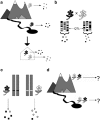The evolution of quantitative traits in complex environments
- PMID: 23612691
- PMCID: PMC3860162
- DOI: 10.1038/hdy.2013.33
The evolution of quantitative traits in complex environments
Abstract
Species inhabit complex environments and respond to selection imposed by numerous abiotic and biotic conditions that vary in both space and time. Environmental heterogeneity strongly influences trait evolution and patterns of adaptive population differentiation. For example, heterogeneity can favor local adaptation, or can promote the evolution of plastic genotypes that alter their phenotypes based on the conditions they encounter. Different abiotic and biotic agents of selection can act synergistically to either accelerate or constrain trait evolution. The environmental context has profound effects on quantitative genetic parameters. For instance, heritabilities measured in controlled conditions often exceed those measured in the field; thus, laboratory experiments could overestimate the potential for a population to respond to selection. Nevertheless, most studies of the genetic basis of ecologically relevant traits are conducted in simplified laboratory environments, which do not reflect the complexity of nature. Here, we advocate for manipulative field experiments in the native ranges of plant species that differ in mating system, life-history strategy and growth form. Field studies are vital to evaluate the roles of disparate agents of selection, to elucidate the targets of selection and to develop a nuanced perspective on the evolution of quantitative traits. Quantitative genetics field studies will also shed light on the potential for natural populations to adapt to novel climates in highly fragmented landscapes. Drawing from our experience with the ecological model system Boechera (Brassicaceae), we discuss advancements possible through dedicated field studies, highlight future research directions and examine the challenges associated with field studies.
Figures



References
-
- Ågren J, Schemske DW. Reciprocal transplants demonstrate strong adaptive differentiation of the model organism Arabidopsis thaliana in its native range. New Phytologist. 2012;194:1112–1122. - PubMed
-
- Alpert P, Simms EL. The relative advantages of plasticity and fixity in different environments: when is it good for a plant to adjust. Evol Ecol. 2002;16:285–297.
Publication types
MeSH terms
Grants and funding
LinkOut - more resources
Full Text Sources
Other Literature Sources

